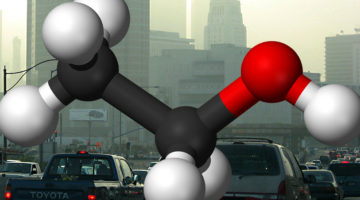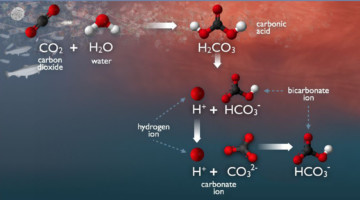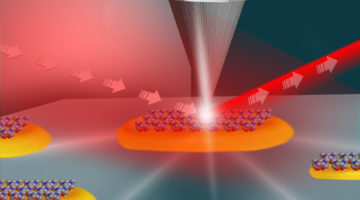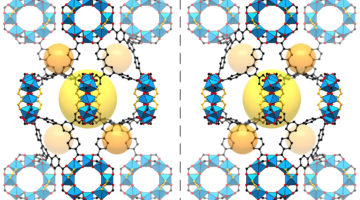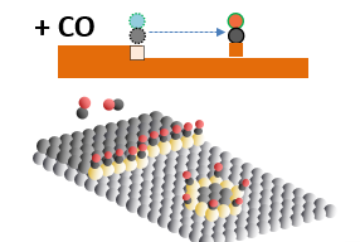X-ray experiments, coupled with theoretical work, revealed how oxygen atoms embedded near the surface of a copper sample had a more dramatic effect on the early stages of a reaction with CO2 than accounted for in earlier theories. This work could prove useful in designing new catalysts for converting CO2 into liquid fuels and other products. Read more »
APXPS Finds Carbonate Reversal at Liquid Interfaces
Aqueous carbonate systems are central to many processes essential to life, from the blood buffer system to the global carbon cycle. Using APXPS, researchers probed the concentration of carbonates near an interface, finding a surprising reversal in the expected abundances as a function of depth. Read more »![]()
![]()
Mapping Catalytic Reactions on Single Nanoparticles
A new study confirms that structural defects and jagged surfaces at the edges of platinum and gold nanoparticles are key hot spots for chemical reactivity. The experiments should help researchers customize the structural properties of catalysts to make them more effective in fostering chemical reactions. Read more »![]()
![]()
Chemistry on the Edge: Study Pinpoints Most Active Areas of Reactions on Nanoscale Particles
Experiments confirm that structural defects at the periphery are key in catalyst function. The SINS study is an important step in chronicling how the atomic structure of nanoparticles impacts their function as catalysts in chemical reactions. Read more »
Exploring the Structure of Aqueous Solutions with SALSA
Researchers have published a series of papers that open up the possibility of probing hydrogen bonds in aqueous solutions by combining x-ray emission spectroscopy and resonant inelastic soft x-ray scattering, using the specialized Solid and Liquid Spectroscopic Analysis (SALSA) endstation at Beamline 8.0.1. Read more »
A New Way to Determine the 3D Structure of Molecules
Researchers have created a sort of nanoscale display case that enables new atomic-scale views of hard-to-study chemical and biological samples. The work could help to reveal new structural details for a range of challenging molecules by stabilizing them inside sturdy structures known as metal-organic frameworks (MOFs). Read more »![]()
![]()
Scientists Trace ‘Poisoning’ in Chemical Reactions to the Atomic Scale
A team of researchers has employed a combination of measurements, including x-ray experiments at the ALS, to gather the most detailed information yet on problematic carbon-based deposits called “coke,” and to find ways to prevent its formation or reduce its effects. Read more »
Formation of Toxic Furans during Combustion
Researchers predicted and observed for the first time the formation and growth of furans and other oxygenated hydrocarbons produced during combustion. These compounds can have a wide range of detrimental effects on human health, air quality, and regional and global climate. Read more »
Researchers Peel Back Another Layer of Chemistry with ‘Tender’ X-Rays
Scientists can now directly probe a previously hard-to-see layer of chemistry, which forms in a narrow band where liquid meets solid, thanks to a unique x-ray toolkit developed at Berkeley Lab. Read more »
An Atomic-Level Understanding of Copper-Based Catalysts
Copper-based catalysts are widely used in chemical industries to convert water and carbon monoxide to hydrogen, carbon dioxide, and methanol. There are theoretical models used to explain this reaction, but a complete understanding of the process has been lacking. However, recent research at the ALS has shed light on the process, giving scientists key data about how copper-based catalysts function at the atomic level. Read more »![]()
![]()
- « Previous Page
- 1
- …
- 9
- 10
- 11
- 12
- 13
- Next Page »
